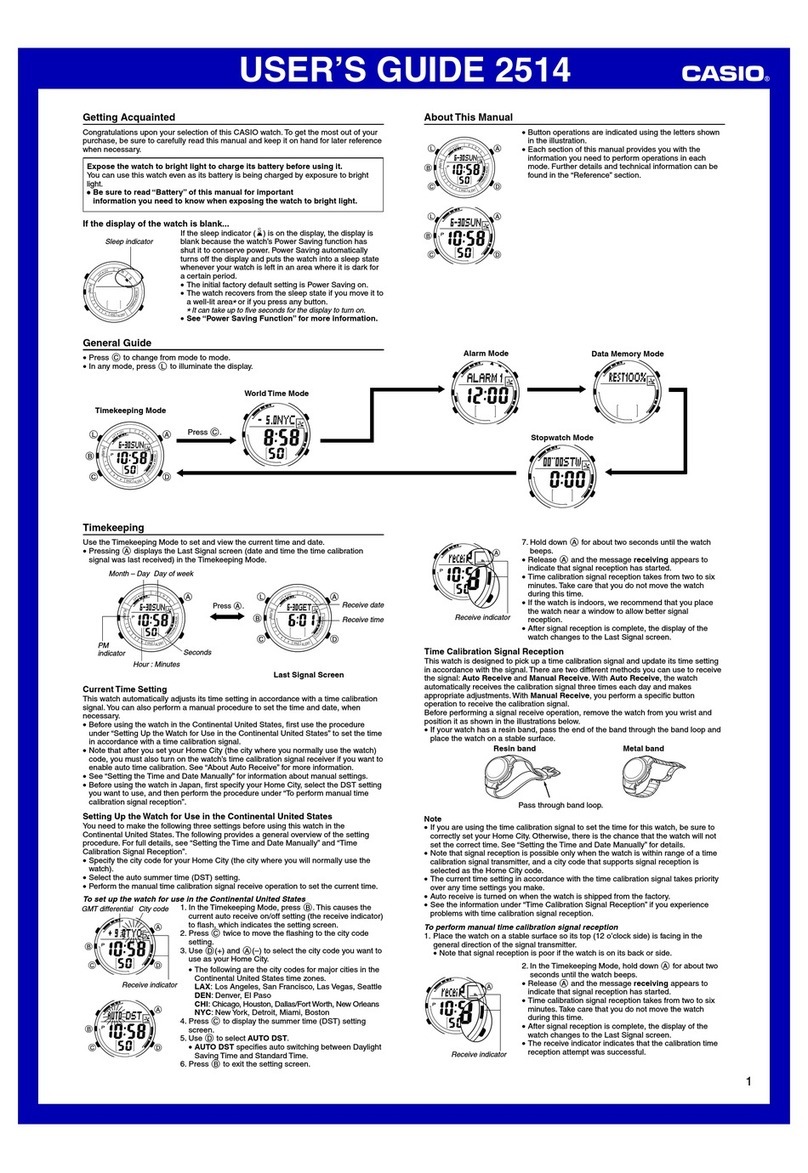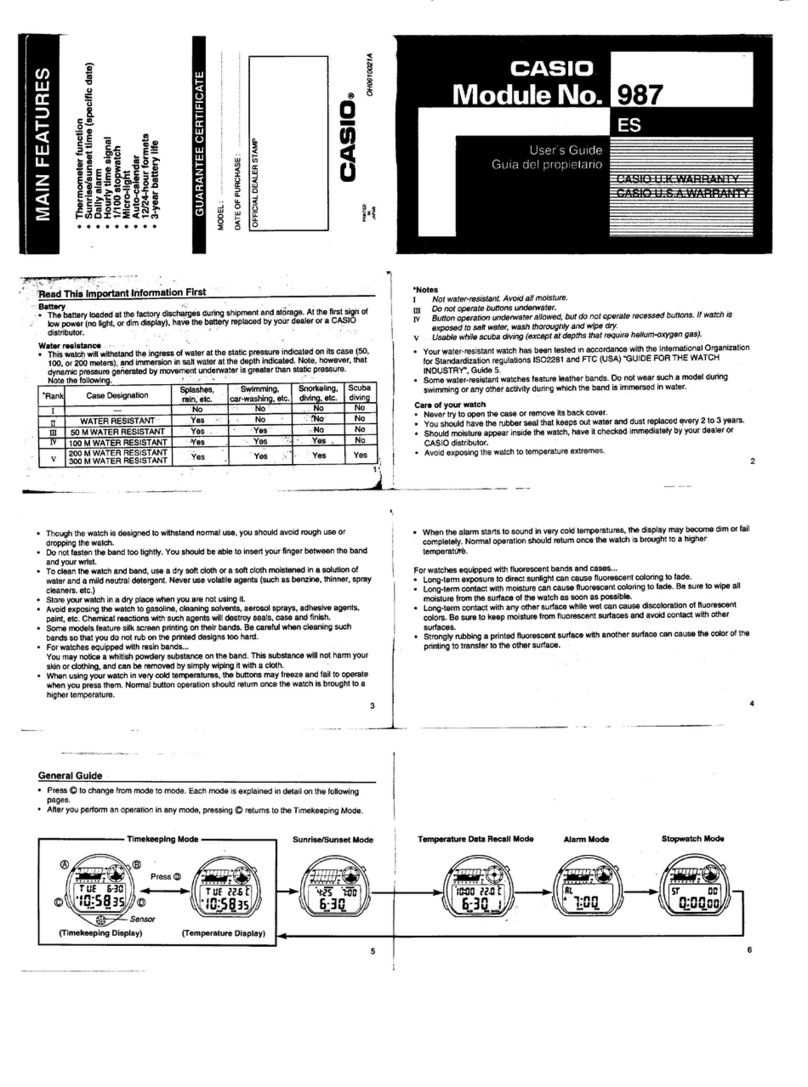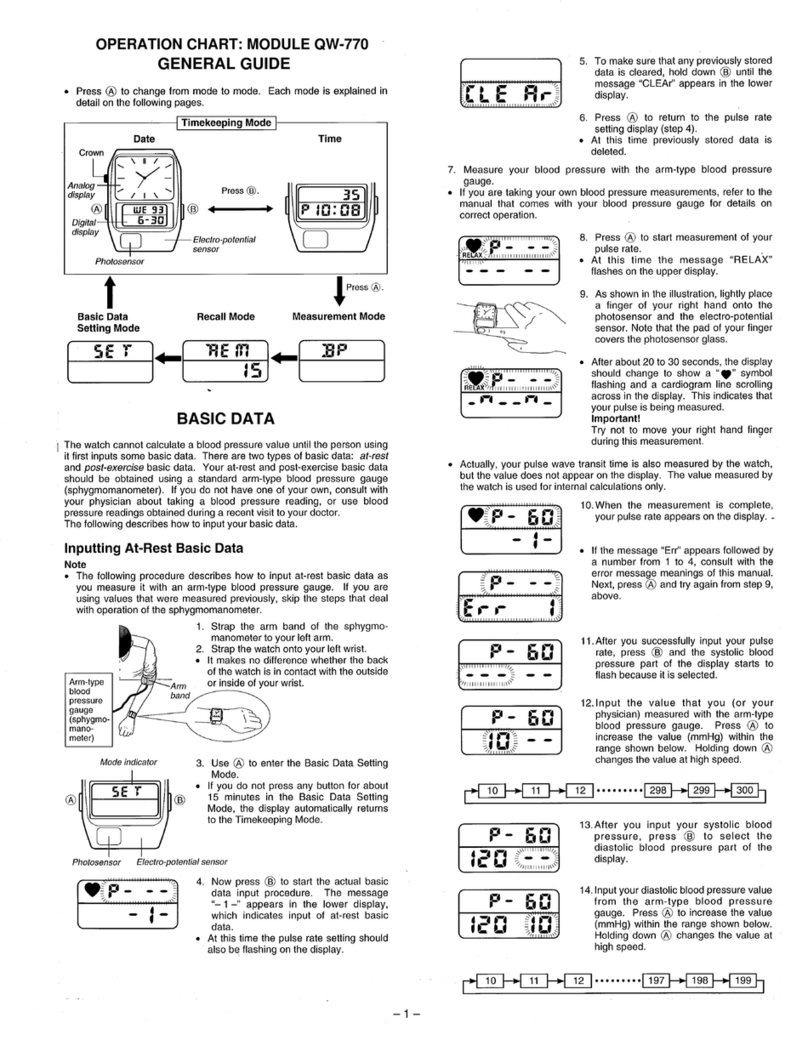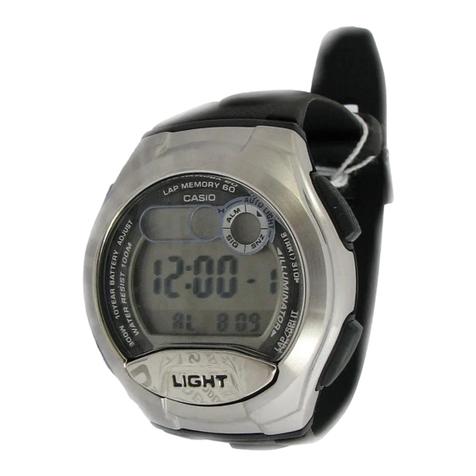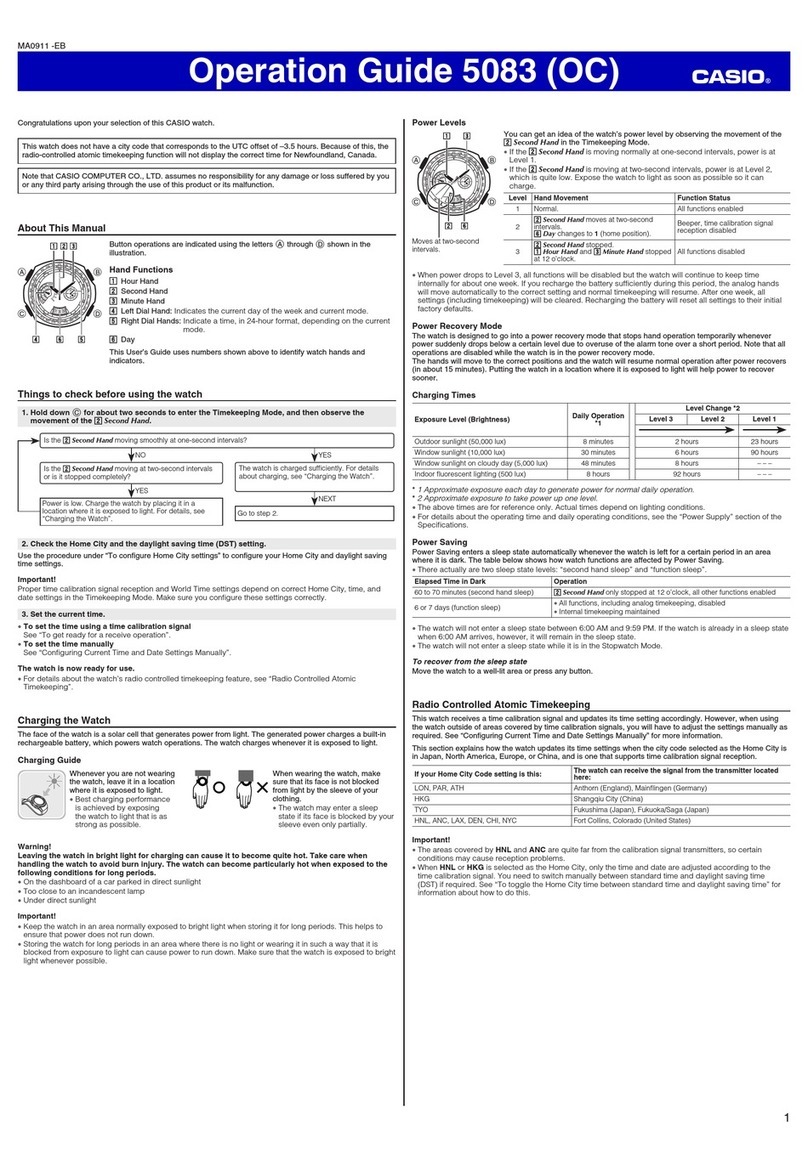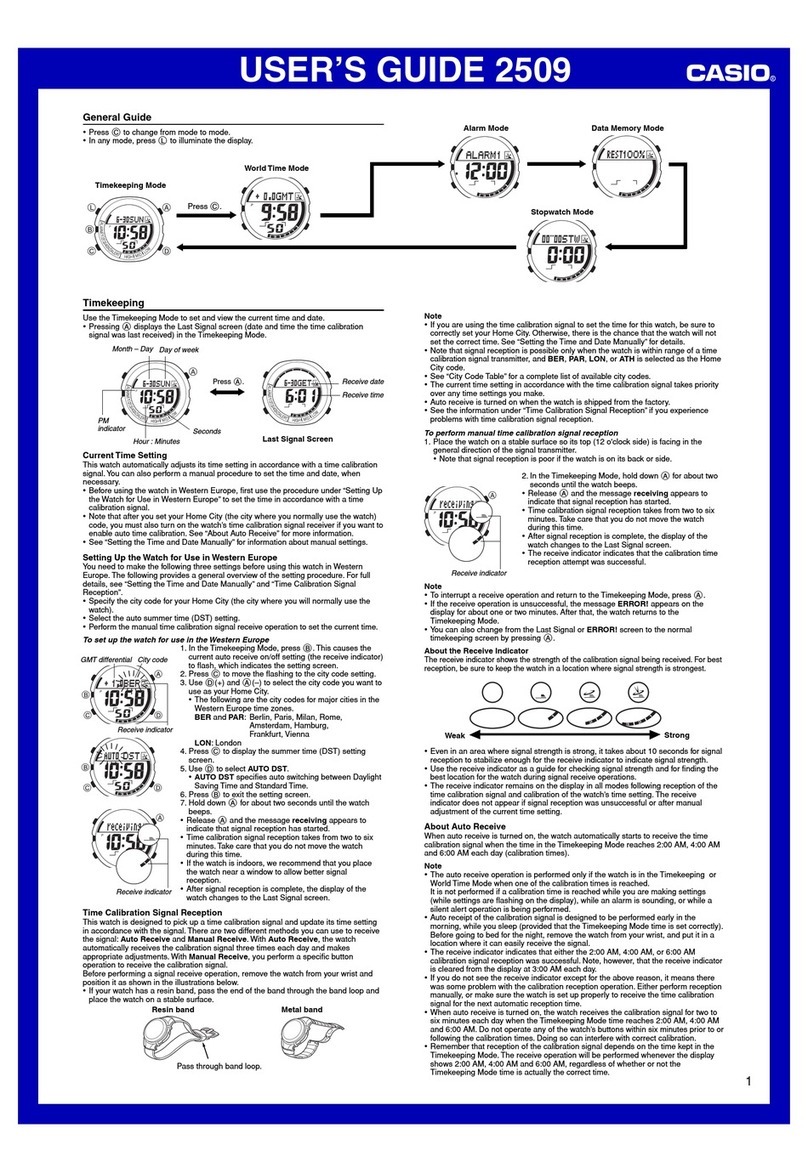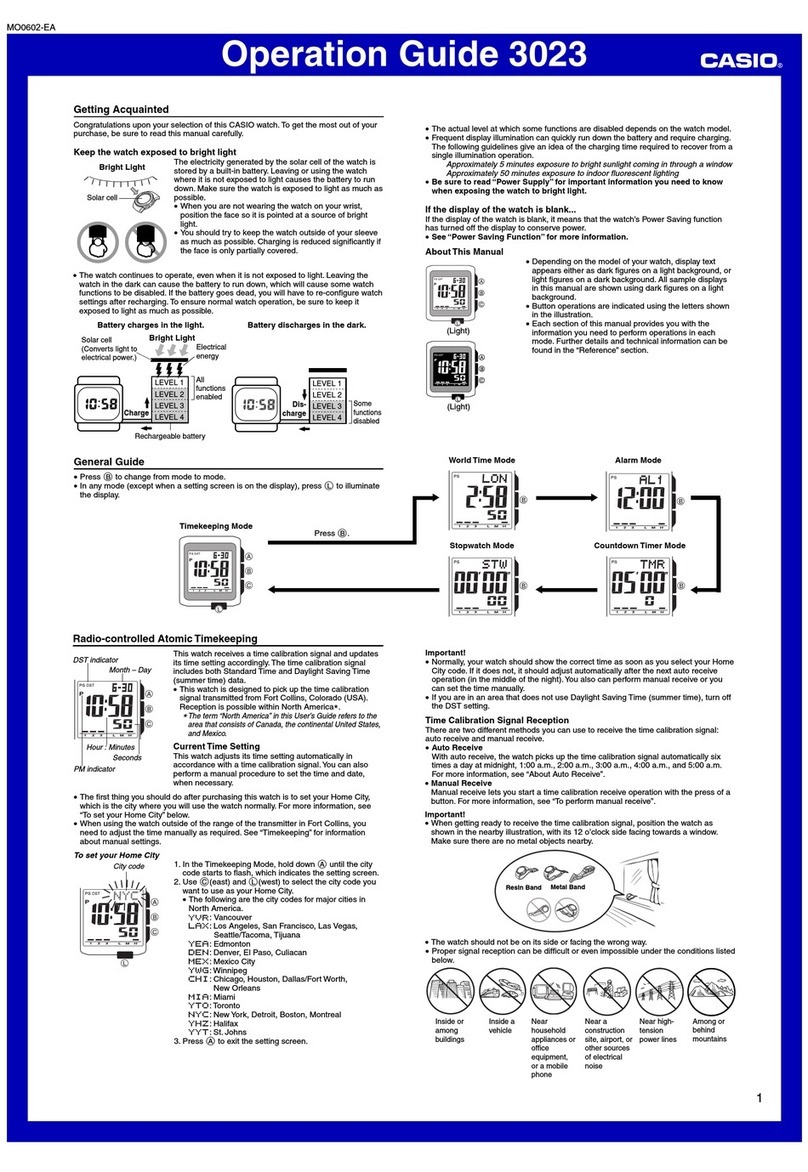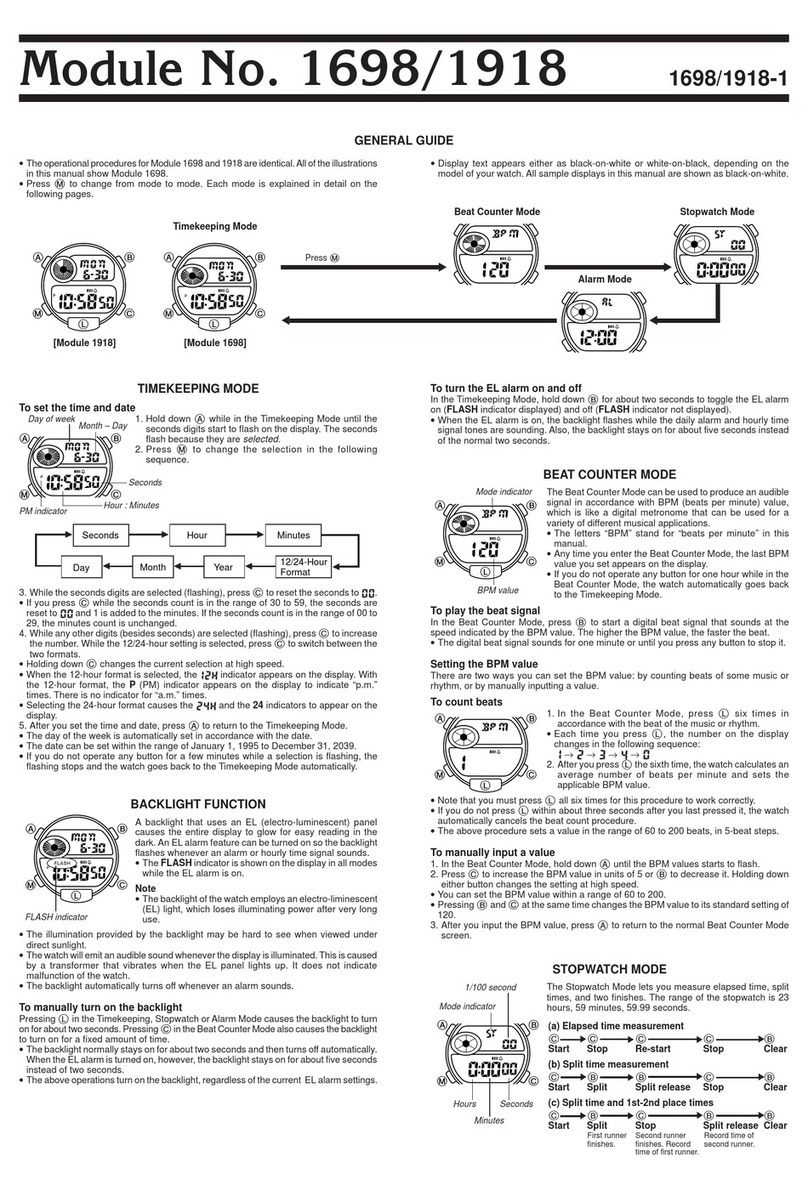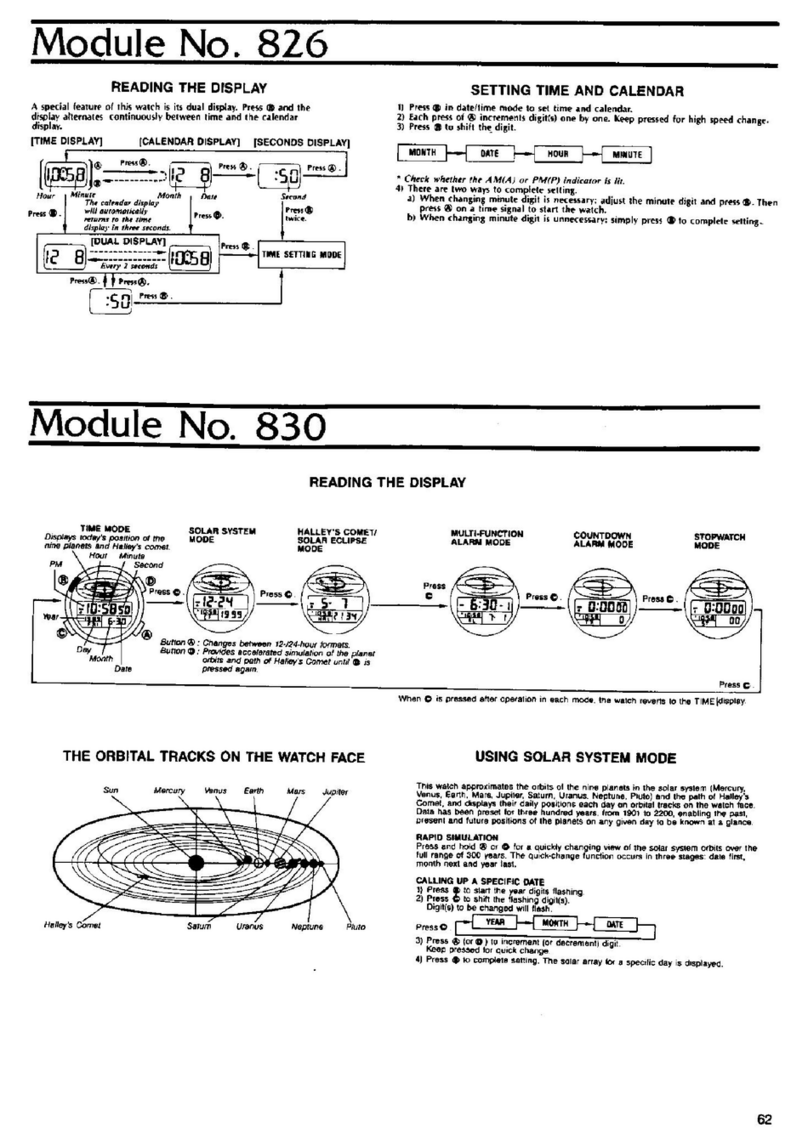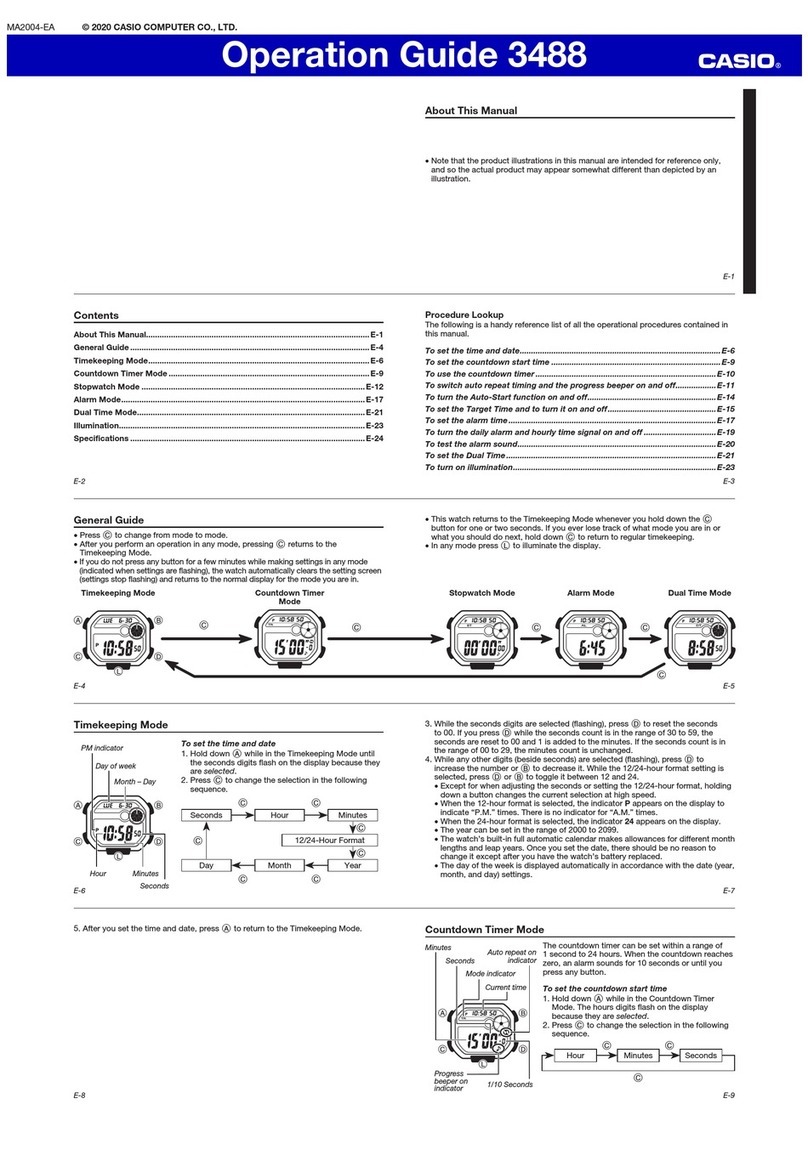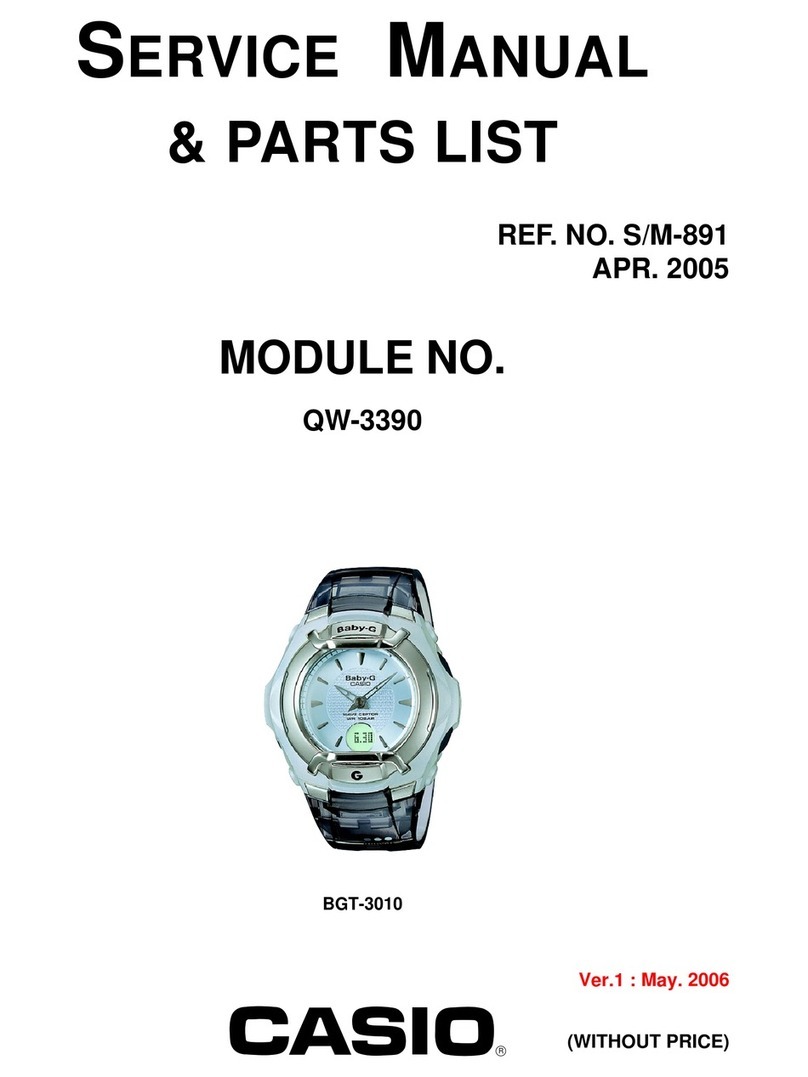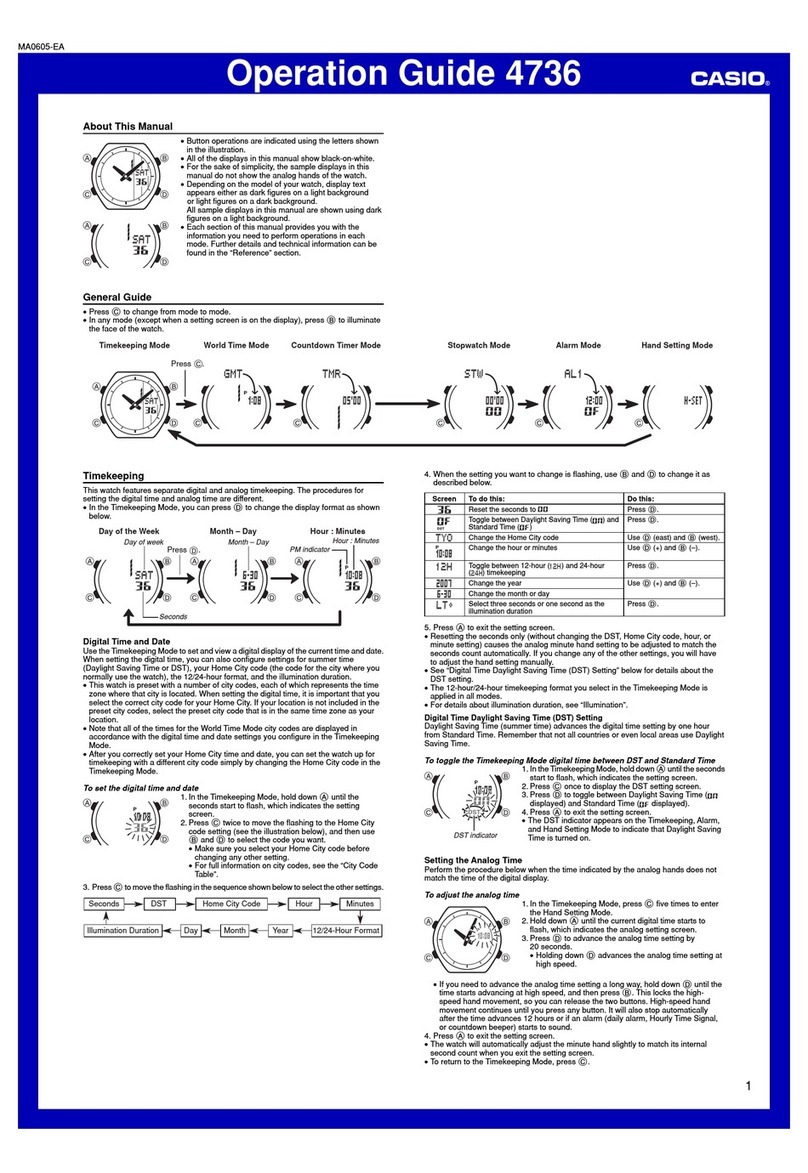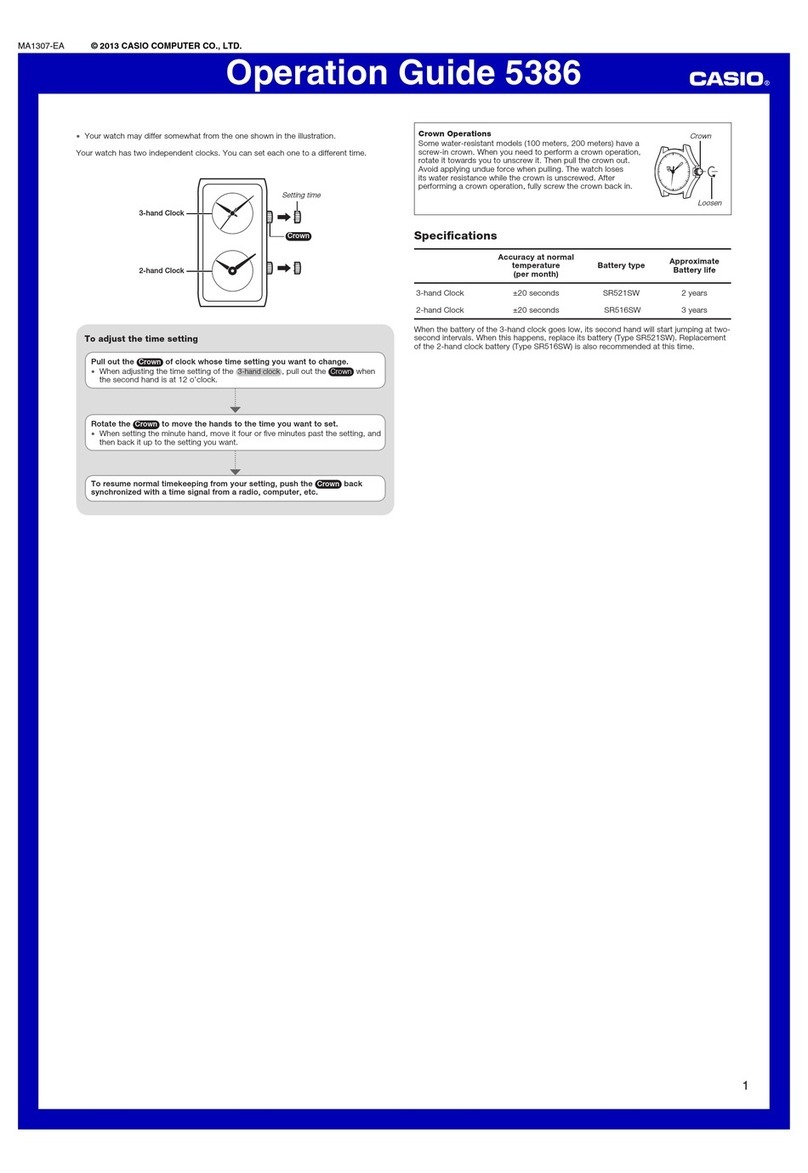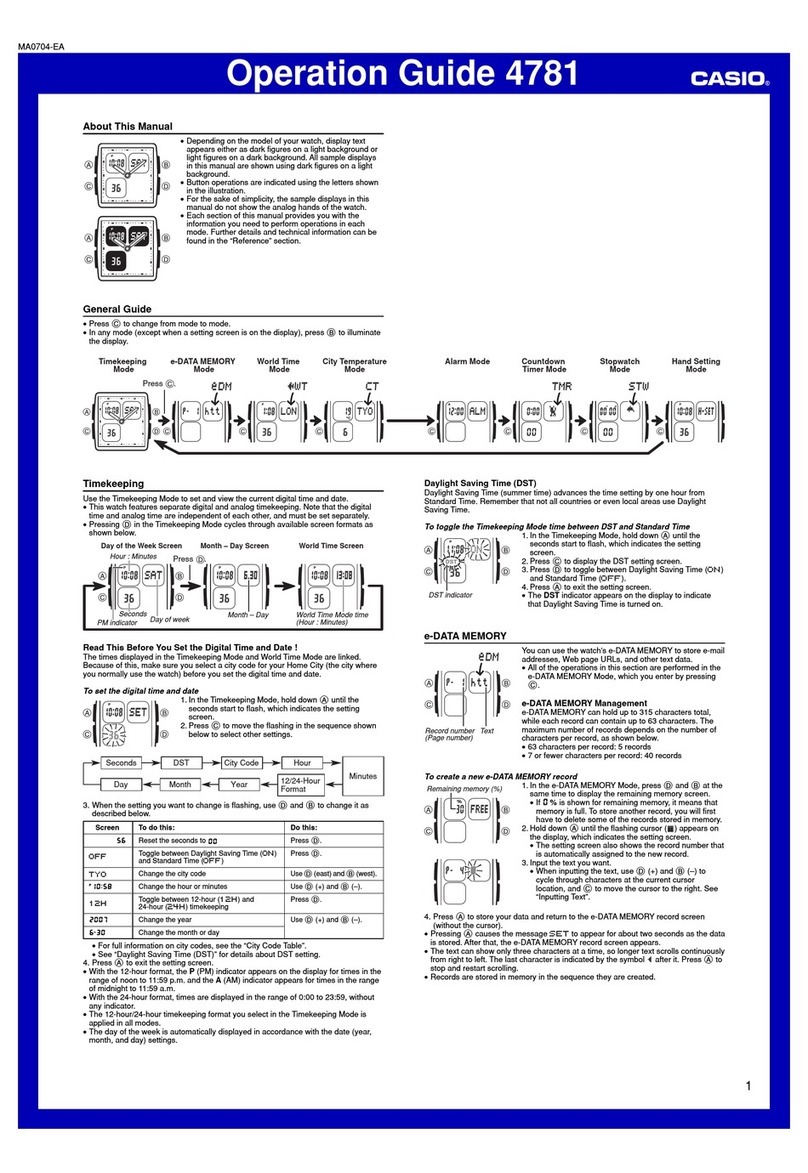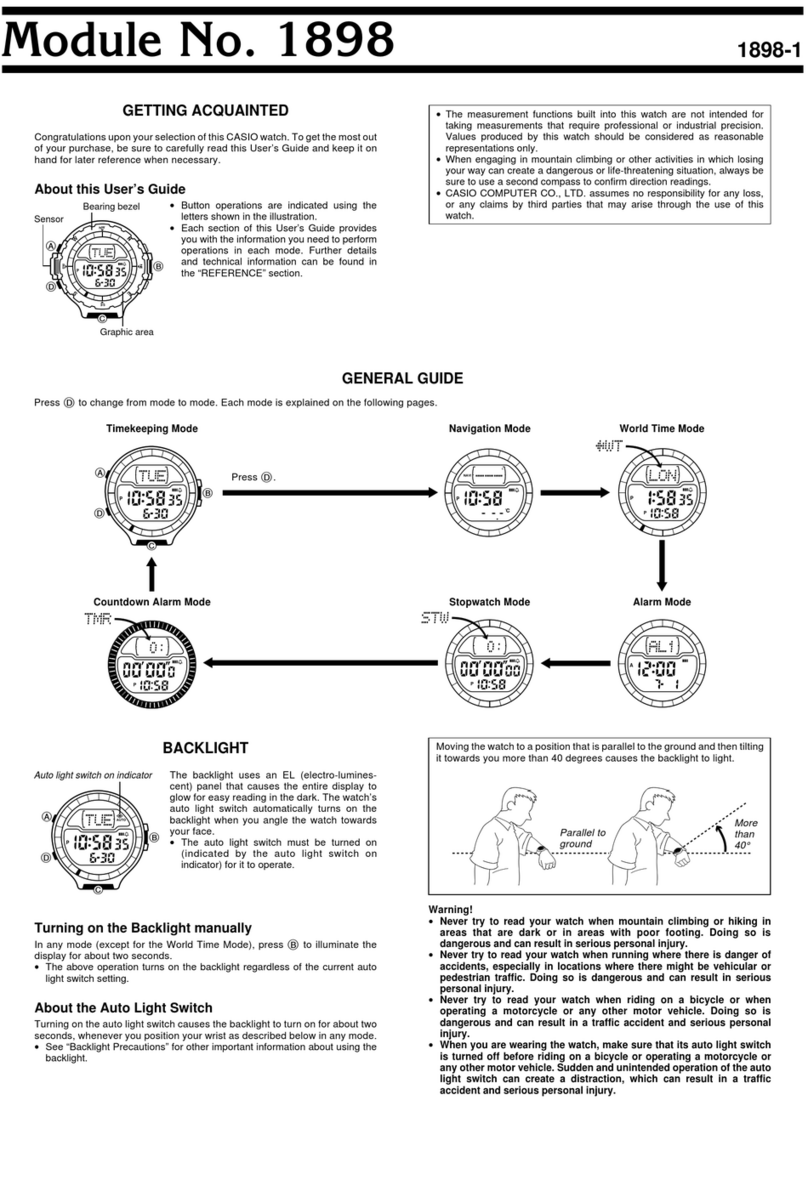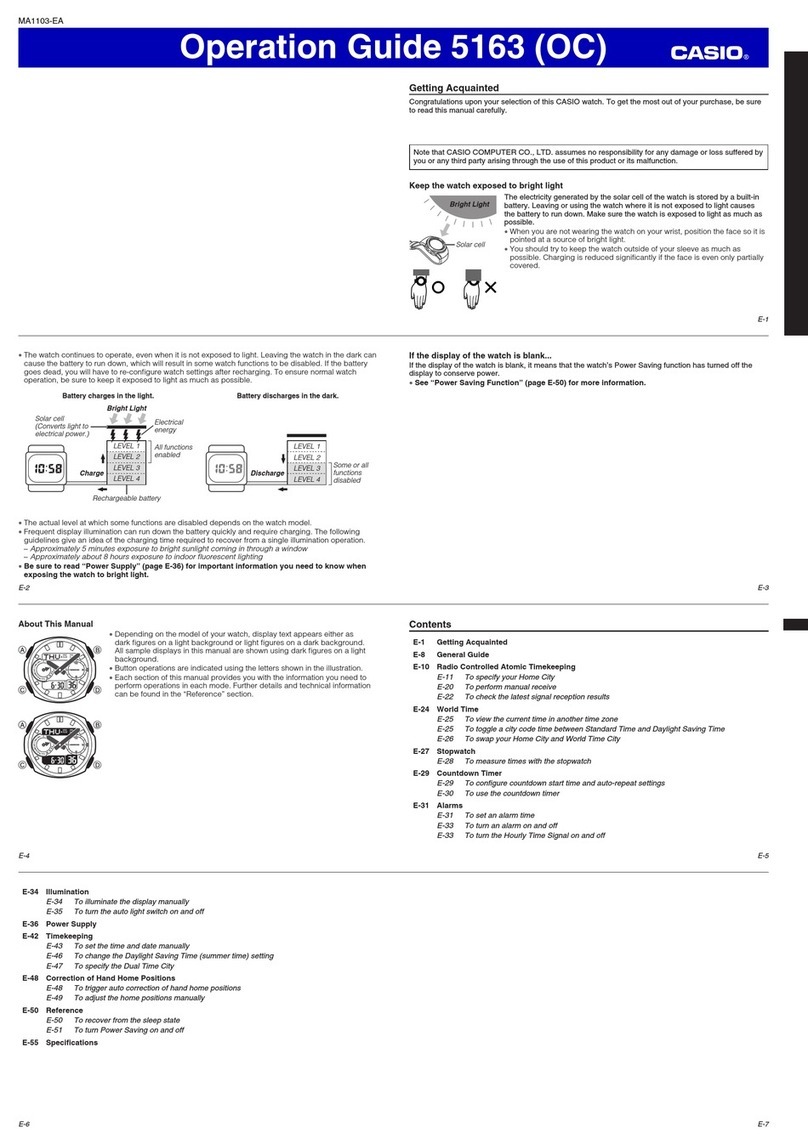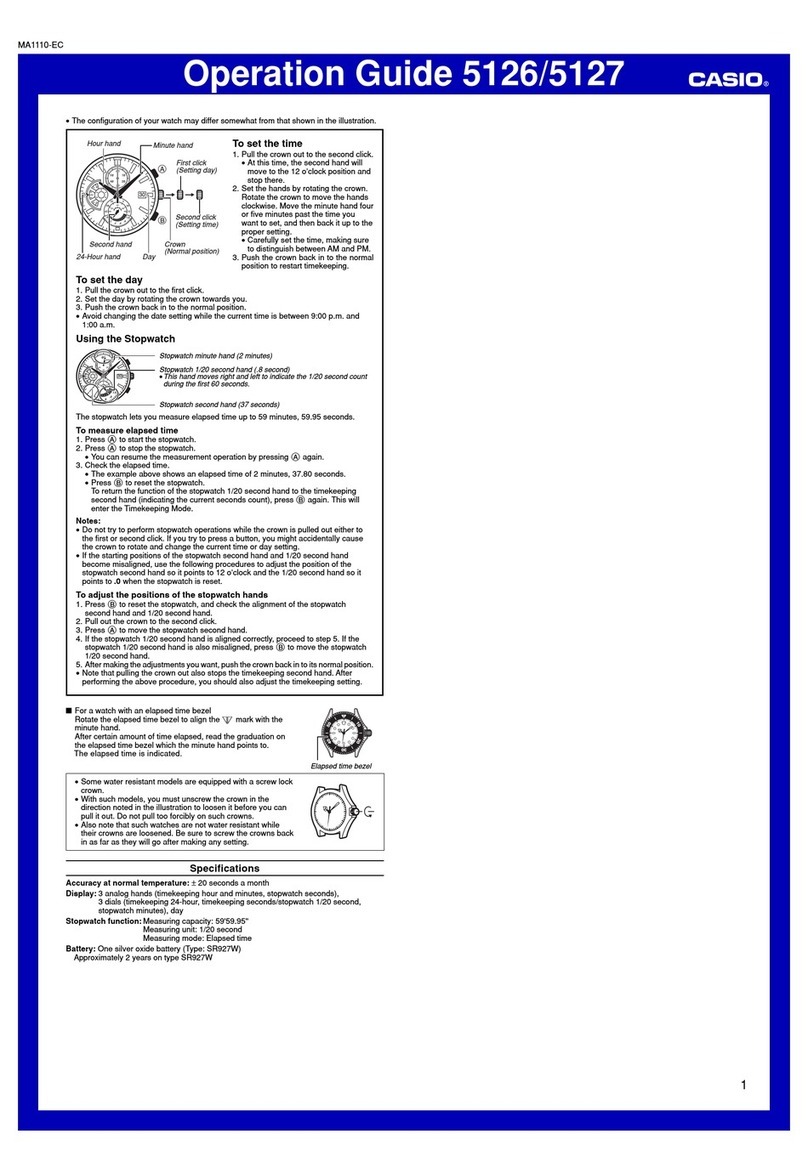
—3 —
■Positioning Your Arm Correctly
•You should be wearing the watch on the outside of your wrist
when using the auto light switch.
•Make sure that the left (9 o’clock)
and right (3 o’clock) sides of the
watch are within
±
15 degrees of
being parallel with the ground.
The auto light switch may not
operate properly if the angle is
greater.
Important!
•The light may be difficult to see if you turn it on under bright
sunlight.
•If you press the Lbutton or if an alarm operation starts while the
display is illuminated, illumination will turn off.
■Charging Precautions
Avoid charging the watch in the following locations, and anywhere
else the watch may become very hot.
•On the dashboard of an automobile parked in the sun
•Very close to an incandescent light source or other sources of
heat
•In a location exposed to direct sunlight for long periods
Note that the display panel may become black under very high
temperatures. This is temporary, and the display will appear
normal again at lower temperatures.
Depending on the light source you are using, the
case of the watch may become quite hot during
charging. Take care to guard against burn injury
after charging.
■Charging the Battery
Point the solar panel (face) of the watch at a light source.
•Remember that even a partial blockage of the solar cell reduces
charging efficiency.
Example: Positioning the watch
Solar Cell
•The illustration shows the resin band model.
■Charging Guide
Starting from a full charge, the watch
should be able to continue operating
for about seven months without
further charging under the conditions
described below.
Daily Use (All time values are
approximate.)
•Illumination: 1.5 seconds
•Alarms: 10 seconds
•Signal reception: 5 times
•Digital display: 18 hours
Making sure the watch is regularly
exposed to light ensure stable
operation.
•Charge Times Required to Advance to a Higher Level
Charging Time
Level 4 Level 3 Level 2 Level 1
– – – – – –
2 hr. 5hr.19hr.
7 hr.
11 hr.
113hr.
22hr.97hr.
36hr.157hr.
Environment
(Luminosity)
Outdoor sunlight
(50,000 lux)
Indoor sunlight
(10,000 lux)
Outdoor overcast
(5,000 lux)
Fluorescent indoor
lighting (500 lux)
•Note that the above charging times are for reference only. Actual
charging time depends on a variety of environmental factors.
The power supply of this watch uses a solar cell to generate
electrical power, which is stored by a rechargeable battery. Using
or storing the watch where it is not regularly exposed to light, or
allowing it to be blocked from light by your sleeve as you are
wearing it can cause the power of the rechargeable battery to run
down. To ensure stable operation, be sure to allow the watch to be
exposed to light as much as possible when you are wearing or
storing it.
Note that all data in memory and all settings are cleared
whenever you allow the level of the rechargeable battery
to drop to Level 4.
■Flashing RECOVER Indicator
If you use the light or alarms a number of times during a short
period, a RECOVER indicator flashes in the top dial, and the
following operations become disabled as battery power recovers.
•Illumination
•Alarm and Hourly Time Signal
•Time calibration signal reception
Normal operation will return after the
battery recovers.
Power Supply
Auto Light Precautions
•Frequent use of the auto light can run down the battery.
•The auto light switch may cause the display to illuminate when
your sleeve covers the display of the watch.
•The display may not illuminate immediately when you angle the
watch towards your face. This does not indicate malfunction.
•The display remains lit for the currently set illumination duration
(1.5 or 2.5 seconds) only, even if you leave the watch angled
towards your face.
•The auto light switch is automatically disabled whenever battery
power is at Level 3 or lower.
•The display may illuminate unintentionally when you wear the
watch on the inside of your wrist, when you shake your arm, or
when you raise your arm. Be sure to turn off the auto light
switch whenever you do not need illumination.
•Keep the auto light switch turned off whenever you are wearing
the watch on the inside of your wrist.
•Electro-static charge and magnetism can interfere with auto light
operation and even make operation impossible. If this happens
lower your arm to the starting position and then raise it again. If
you still have trouble with illumination, try lowering your arm down
to your side and then raise it to your face for reading.
Illumination
RECOVER
Indicator
Required Daily Charging Time
•
The following is the daily
amount of charging required
each day to support the
operations under “Daily Use”.
Environment
(Luminosity)
Outdoor sunlight
(50,000 lux)
Indoor sunlight
(10,000 lux)
Outdoor overcast
(5,000 lux)
Fluorescent indoor
lighting (500 lux)
6min.
30min.
48min.
8hr.
Charging
Time
Rotate your arm so the watch
is angled at about 40 degrees,
so you can read its face.
With the watch on
your wrist, position it
level with the ground.
11
11
122
22
2
More
than 40
degrees
■Battery Indicator
All functions enabled.
All functions enabled.
Level
1
Level
2
Level
3
Level
4
Display, illumination, alarms, Hourly
Time Signal, signal reception, and
analog timekeeping disabled.
All functions, including digital
timekeeping, disabled.
Black-On-
White
Display
White-On-
Black
Display
•Exposing the watch to direct sunlight or other strong light may cause
the battery level indicator to momentarily indicate a level that is higher
than the actual battery level. Because of this, you should wait for a
short while after charging to check the battery level indicator.
•Even if the battery level drops all the way to Level 4, you will still
be able to recharge the battery and use the watch again.
•When recharging from Level 4, set the current time and date after
the battery level recharges to Level 3. At this time you should
continue to expose the watch to light so it can charge up to Level
2 or Level 1.
■Start charging at Level 3!
Battery Level 3 indicates that remaining battery power is very low.
Be sure to expose the watch to light for recharging as soon as
possible after the battery level indicator shows Level 3.
Illuminating the Display with the
Auto Light Switch
The auto light switch automatically illuminates the display
whenever you angle the watch towards your face for reading,
but only when it is dark.
You can use the procedure under “Specifying the Illumination
Duration”to configure the illumination duration as
approximately 1.5 seconds or 2.5 seconds.
•The auto light switch does not illuminate the display when
surrounding light is bright.
The auto light switch illuminates the display in all modes.
Turning the Auto Light Switch On and Off
In any mode, hold down the Lbutton for about two seconds to
toggle the auto light switch on (auto light switch on indicator
displayed in the upper dial) and off (no indicator displayed).
Auto light switch
on indicator
An LED is used to illuminate the display for easy reading in the
dark. An auto light switch automatically turns on illumination when
you angle the watch towards your face for reading.
Illuminating the Display Manually
Press the LL
LL
Lbutton in any
mode to illuminate the display.
•You can use the procedure under
“Specifying the Illumination
Duration”to configure the
illumination duration as
approximately 1.5 seconds or 2.5
seconds.
•Pressing the Lbutton
illuminates the display regardless
of whether the auto light switch is
on or off.
You may hear a faint rattling sound when you move the watch
around. This sound is caused by the movement of a metal
bulb that controls operation of the auto light switch, and does
not indicate malfunction.
